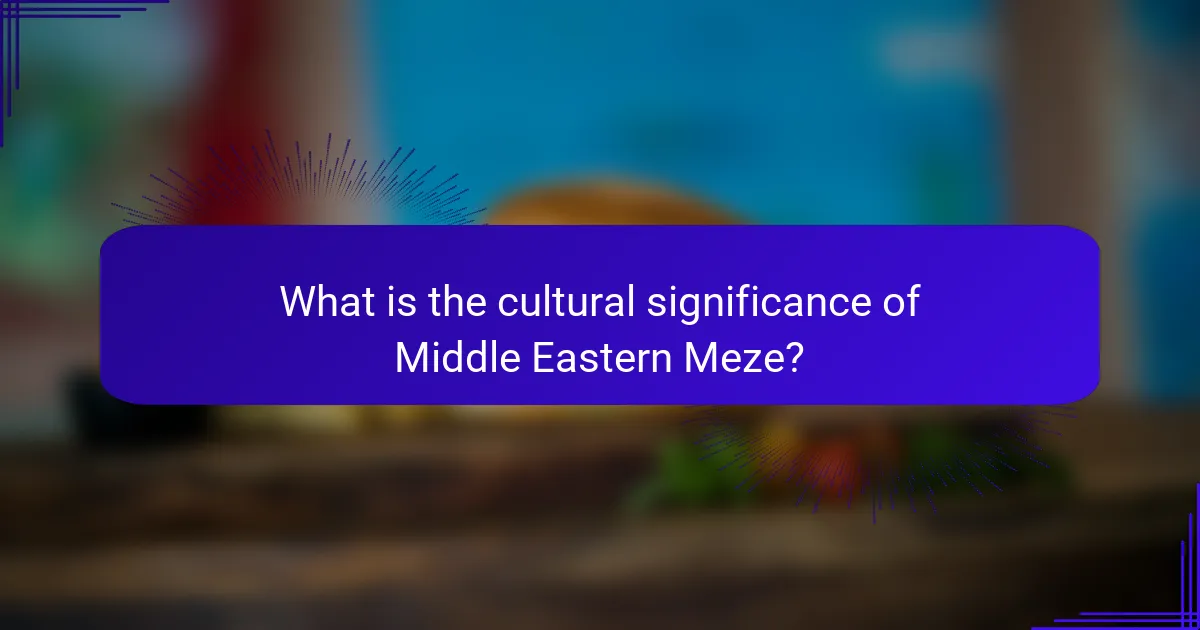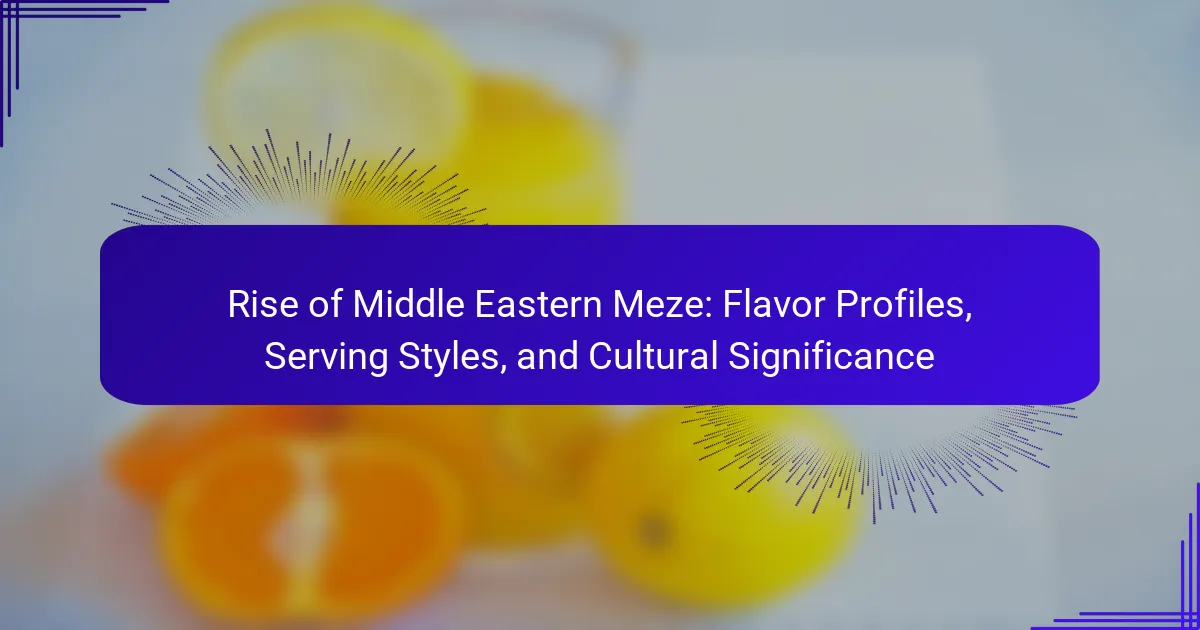
What is Middle Eastern Meze?
Middle Eastern Meze is a selection of small dishes served as appetizers. It often includes a variety of flavors and textures. Common items in Meze are hummus, baba ghanoush, and tabbouleh. These dishes are typically served with pita bread or vegetables. Meze is popular in countries like Lebanon, Turkey, and Greece. It reflects the region’s culinary diversity and communal dining culture. The tradition of Meze encourages sharing and social interaction during meals. Historical records show that Meze has been a part of Middle Eastern cuisine for centuries.
How did Middle Eastern Meze originate?
Middle Eastern Meze originated as a traditional way of serving small dishes during social gatherings. This practice encourages sharing and communal dining, reflecting the region’s hospitality culture. Historical records indicate that Meze has roots in ancient civilizations, including the Greeks and Ottomans. The diversity of ingredients used in Meze showcases the agricultural richness of the Middle East. Common items include dips, salads, and grilled meats, all highlighting local flavors. Over time, Meze evolved into a culinary art form, celebrated for its variety and presentation. Today, it remains a staple in Middle Eastern cuisine, symbolizing togetherness and cultural identity.
What historical influences shaped the development of Meze?
Meze developed through various historical influences, primarily from the Ottoman Empire and Mediterranean cultures. The Ottoman Empire, which spanned from the 14th to the early 20th century, integrated diverse culinary traditions. This integration led to the creation of a variety of small dishes served as appetizers. Mediterranean cultures contributed ingredients like olives, cheeses, and fresh vegetables, enriching the meze repertoire. Trade routes facilitated the exchange of spices and cooking techniques, further diversifying meze offerings. Historical events, such as conquests and migrations, also played a role in shaping regional variations of meze. Each region adapted meze to local tastes and available ingredients, resulting in unique interpretations. The communal aspect of meze dining reflects cultural practices emphasizing sharing and socializing.
How has the concept of Meze evolved over time?
The concept of Meze has evolved significantly from its origins in the Eastern Mediterranean. Initially, Meze consisted of simple, local ingredients served as appetizers. Over time, it expanded to include a diverse range of dishes reflecting regional flavors and culinary techniques. Historical trade routes influenced ingredient availability, introducing spices and herbs that enriched Meze offerings. The Ottoman Empire played a crucial role in popularizing Meze across various cultures, leading to its integration into social dining experiences. Today, Meze is celebrated for its variety, often served in communal settings, fostering social interaction. The evolution of Meze mirrors cultural exchanges and globalization, showcasing culinary diversity while maintaining traditional roots.
What are the key components of Middle Eastern Meze?
The key components of Middle Eastern Meze include a variety of small dishes served as appetizers. Common items are hummus, baba ghanoush, tabbouleh, and stuffed grape leaves. These dishes often feature fresh vegetables, legumes, and grains. Olive oil and spices are essential for flavoring. Meze can also include cheeses and cured meats. The presentation is typically colorful and diverse. This variety encourages sharing and social interaction during meals. Meze reflects the culinary traditions of the Middle East, emphasizing fresh and vibrant ingredients.
What types of dishes are typically included in Meze?
Meze typically includes a variety of small dishes served as appetizers. Common dishes in meze are hummus, baba ghanoush, and tabbouleh. Other popular items include stuffed grape leaves and falafel. Olives, cheeses, and assorted dips are also frequently featured. Additionally, grilled vegetables and meats may be included. Each dish highlights different flavors and textures. Meze is often enjoyed with pita bread or other types of bread. This variety encourages sharing and communal dining experiences.
How do ingredients vary across different regions?
Ingredients vary across different regions due to climate, culture, and availability. For instance, Mediterranean regions utilize olive oil, while Middle Eastern cuisines often favor tahini. Local spices, such as za’atar in Levantine dishes, highlight regional flavor preferences. The use of fresh herbs like cilantro in some areas contrasts with dried herbs favored elsewhere. Additionally, staple ingredients like grains differ; couscous is prevalent in North Africa, while bulgur is common in Turkey. Seasonal variations also influence ingredient choices, impacting freshness and flavor. Historical trade routes have introduced unique ingredients, further diversifying regional cuisines.
What flavor profiles are characteristic of Middle Eastern Meze?
Middle Eastern Meze is characterized by a diverse range of flavor profiles. Common flavors include tangy, spicy, and savory notes. Ingredients like lemon, garlic, and herbs enhance the tanginess. Spices such as cumin and coriander contribute to the savory and spicy aspects. The use of olive oil adds richness and depth. Dishes often feature fresh vegetables and legumes, providing earthy flavors. Additionally, yogurt-based dips offer creaminess and cooling effects. The combination of these elements creates a harmonious and vibrant culinary experience.
Which spices and herbs are commonly used in Meze dishes?
Common spices and herbs used in Meze dishes include sumac, za’atar, and cumin. Sumac adds a tangy flavor and is often sprinkled on salads and dips. Za’atar is a blend of herbs, sesame seeds, and salt, enhancing the taste of breads and spreads. Cumin provides an earthy flavor and is frequently used in various Meze preparations. Other notable herbs include parsley and mint, which are often used fresh in salads and garnishes. These spices and herbs contribute to the vibrant flavor profiles characteristic of Meze.
How do cooking methods influence the flavors of Meze?
Cooking methods significantly influence the flavors of Meze. Different techniques such as grilling, frying, and baking impart distinct tastes. Grilling enhances the smoky flavor, while frying adds crispiness and richness. Baking allows for a more subtle flavor development, often bringing out the natural sweetness of ingredients. Additionally, slow-cooking methods can deepen flavors through the melding of spices and herbs. For example, grilled vegetables in Meze acquire a charred taste that complements dips like baba ghanoush. Each method also affects texture, which is integral to the overall sensory experience of Meze.

What are the serving styles of Middle Eastern Meze?
Middle Eastern Meze is typically served in a communal style. Dishes are placed on a shared table for all to enjoy. This encourages social interaction and sharing among diners. Meze can also be served as a buffet, allowing guests to choose their favorites. Alternatively, it may be presented in individual portions for a more formal dining experience. The variety of dishes enhances the overall dining experience. Traditional serving often includes bread, dips, and small plates. Each style reflects the cultural significance of communal eating in Middle Eastern traditions.
How is Meze traditionally served in Middle Eastern cultures?
Meze is traditionally served as a variety of small dishes in Middle Eastern cultures. It is often presented on a large platter or table, allowing for communal sharing. Diners typically enjoy meze with pita bread or other forms of flatbread. The selection can include dips like hummus and baba ghanoush, along with salads, olives, and cheeses. Each dish is meant to be sampled in small portions. Meze is commonly enjoyed before a main meal, facilitating social interaction. This practice emphasizes hospitality and the enjoyment of flavors together. The tradition of serving meze dates back centuries, reflecting the region’s rich culinary heritage.
What is the significance of communal dining in Meze culture?
Communal dining is central to Meze culture as it fosters social connection and shared experiences. This dining style emphasizes togetherness and hospitality among participants. In Meze, various small dishes are served, encouraging diners to share and sample multiple flavors. This practice enhances the enjoyment of food through collective participation. Additionally, communal dining reflects cultural values of generosity and unity in Middle Eastern societies. Historical traditions highlight that meals are often a communal affair, strengthening familial and communal bonds. Studies show that shared meals can improve relationships and enhance emotional well-being.
How do presentation styles vary in different settings?
Presentation styles vary significantly across different settings. In formal settings, presentations often rely on structured formats with visual aids. These presentations emphasize clarity and professionalism. In contrast, informal settings tend to favor conversational styles. They encourage audience interaction and personal storytelling. Cultural influences also shape presentation styles. For instance, Middle Eastern settings may incorporate communal sharing of food, enhancing engagement. The use of vibrant colors and decorative platters is common in such contexts. Research indicates that visual and cultural elements affect audience perception and retention. Understanding these variations is crucial for effective communication.
What are the modern adaptations of Meze serving styles?
Modern adaptations of Meze serving styles include tapas-inspired presentations and shared platters. These adaptations emphasize communal dining experiences. Many restaurants now offer a variety of small dishes for sharing. This approach encourages social interaction among diners. Additionally, some chefs incorporate global flavors into traditional Meze. For example, fusion dishes blend Middle Eastern ingredients with Asian or Latin American cuisines. Another trend is the use of modern plating techniques. This enhances the visual appeal of the Meze offerings. Furthermore, the rise of vegetarian and vegan options reflects changing dietary preferences. These adaptations make Meze more accessible to diverse audiences.
How have contemporary restaurants reinterpreted Meze?
Contemporary restaurants have reinterpreted Meze by modernizing traditional dishes and presentation styles. They often incorporate diverse ingredients and flavors from various cuisines. This fusion approach enhances the traditional Meze experience, making it more appealing to a global audience. Many restaurants serve Meze in a tapas-style format, encouraging sharing and communal dining. Additionally, plating aesthetics have become a focus, with vibrant colors and artistic arrangements. Chefs are also experimenting with textures and temperatures, creating innovative interpretations of classic Meze items. These changes reflect a broader trend towards culinary creativity and cultural exchange in dining.
What fusion trends are emerging in Meze presentations?
Emerging fusion trends in Meze presentations include the incorporation of global flavors and techniques. Chefs are blending traditional Middle Eastern ingredients with Asian and Mediterranean elements. For instance, using miso in hummus or adding kimchi to tabbouleh is becoming popular. These innovations enhance flavor profiles and create unique dining experiences. Additionally, visual presentation is evolving, with colorful and artistic arrangements that emphasize aesthetics. Fusion Meze platters often feature a combination of textures and colors, appealing to modern diners. These trends reflect a broader culinary movement toward experimentation and creativity in traditional dishes.

What is the cultural significance of Middle Eastern Meze?
Middle Eastern Meze holds significant cultural importance as it embodies communal dining and hospitality traditions. This style of serving small dishes fosters social interaction and sharing among guests. Meze reflects the region’s diverse culinary heritage, showcasing various flavors and ingredients. It often includes items like hummus, baba ghanoush, and tabbouleh, highlighting local agricultural products. The practice of enjoying Meze is integral to celebrations and gatherings, reinforcing community bonds. Historically, Meze has roots in ancient civilizations, emphasizing its longstanding role in Middle Eastern culture. This tradition continues to evolve, adapting to modern tastes while preserving its essence.
How does Meze reflect social customs and traditions?
Meze reflects social customs and traditions by serving as a communal dining experience. It encourages sharing and conversation among diners. This practice fosters social bonds and hospitality, which are vital in Middle Eastern cultures. Traditionally, meze is served during gatherings and celebrations, highlighting its role in social rituals. The variety of dishes represents regional diversity and cultural heritage. Additionally, the preparation and presentation of meze often involve family recipes, linking generations. Overall, meze embodies the essence of community and cultural identity in the Middle East.
What role does Meze play in celebrations and gatherings?
Meze serves as a central element in celebrations and gatherings within Middle Eastern culture. It fosters communal dining and social interaction. Meze consists of various small dishes, allowing guests to sample a range of flavors. This sharing style promotes a sense of togetherness and hospitality. Traditionally, meze is served during festive occasions, such as weddings and holidays. It enhances the dining experience by encouraging conversation and connection among guests. The variety of meze dishes reflects the region’s rich culinary heritage. Overall, meze plays a vital role in enhancing the celebratory atmosphere and strengthening social bonds.
How does Meze contribute to cultural identity in the Middle East?
Meze contributes to cultural identity in the Middle East by serving as a communal dining experience that reflects regional customs. It showcases a variety of flavors and ingredients unique to Middle Eastern cuisine. The diversity of dishes in meze represents the cultural richness of different communities in the region. Sharing meze fosters social interaction and strengthens family and community bonds. Traditional meze often includes items like hummus, baba ghanoush, and tabbouleh, which have historical significance. These dishes are often prepared using age-old recipes passed down through generations. The practice of serving meze highlights hospitality, an important cultural value in the Middle East. Overall, meze embodies the culinary heritage and social traditions that are integral to the cultural identity of the region.
What are the health benefits associated with Middle Eastern Meze?
Middle Eastern Meze offers numerous health benefits. It typically includes a variety of dishes such as hummus, tabbouleh, and baba ghanoush. These dishes are rich in vegetables, legumes, and healthy fats. They provide essential nutrients like vitamins, minerals, and antioxidants. For example, chickpeas in hummus are high in protein and fiber. Fiber aids digestion and supports heart health. Olive oil, often used in Meze, contains monounsaturated fats beneficial for cardiovascular health. Additionally, many Meze dishes are low in calories, promoting weight management. The variety in Meze encourages balanced eating and portion control. Overall, Middle Eastern Meze contributes to a nutritious and well-rounded diet.
Which ingredients in Meze promote well-being?
Olive oil, chickpeas, and yogurt are key ingredients in Meze that promote well-being. Olive oil is rich in monounsaturated fats and antioxidants. It supports heart health and reduces inflammation. Chickpeas provide protein and fiber, aiding digestion and maintaining stable blood sugar levels. Yogurt contains probiotics, which enhance gut health and boost the immune system. These ingredients contribute to a balanced diet, promoting overall health and wellness.
How can Meze be incorporated into a balanced diet?
Meze can be incorporated into a balanced diet by including a variety of small dishes that emphasize whole ingredients. These dishes often feature vegetables, legumes, whole grains, and lean proteins. For example, hummus provides plant-based protein and fiber. Tabbouleh is rich in fresh herbs and whole grains, contributing vitamins and minerals.
Serving meze with a variety of colorful vegetables enhances nutrient intake. Using olive oil in moderation adds healthy fats. Including fermented options like yogurt can support gut health.
Meze encourages portion control due to its small servings, promoting mindful eating. Research indicates that Mediterranean diets, which include meze, are associated with numerous health benefits, such as reduced heart disease risk.
What tips can enhance the Meze dining experience?
To enhance the Meze dining experience, consider sharing a variety of dishes. Meze typically consists of small plates, encouraging communal dining. Pairing dishes with complementary beverages, like arak or wine, can elevate flavors. Incorporating fresh bread or pita enhances texture and taste. Serving dishes at room temperature allows for optimal flavor enjoyment. Engaging in conversation while dining fosters a social atmosphere. Finally, presenting food on attractive platters adds visual appeal, enhancing the overall experience.
How can one create a diverse Meze platter at home?
To create a diverse Meze platter at home, include a variety of small dishes that represent different flavors and textures. Start with traditional dips like hummus, baba ghanoush, and tzatziki. Incorporate various fresh vegetables, such as cucumbers, bell peppers, and cherry tomatoes for crunch. Add a selection of olives and pickles for tanginess. Include different cheeses, like feta or labneh, for creaminess. Offer pita bread or flatbreads for dipping and scooping. Complement the platter with grilled meats or falafel for protein. Garnish with fresh herbs like parsley or mint for added flavor. This variety reflects the cultural significance of Meze in Middle Eastern cuisine, where sharing food enhances social connections.
What are some common mistakes to avoid when serving Meze?
Common mistakes to avoid when serving Meze include overcrowding the table with too many dishes. This can overwhelm guests and dilute the experience. Another mistake is not providing a variety of flavors and textures. Meze should offer a balance of savory, spicy, and refreshing options. Failing to serve dishes at the correct temperature is also problematic. Cold dishes should be served chilled, while warm dishes need to be hot. Additionally, neglecting to provide appropriate utensils can hinder enjoyment. Guests should have the right tools to savor each dish. Lastly, overlooking dietary restrictions can alienate guests. It’s essential to consider vegetarian, vegan, and gluten-free options when planning the menu.
Middle Eastern Meze is a collection of small dishes served as appetizers, reflecting the region’s culinary diversity and communal dining culture. This article explores the origins, historical influences, and evolution of Meze, highlighting key components such as hummus, baba ghanoush, and tabbouleh. It examines flavor profiles, common ingredients, and cooking methods that shape Meze’s unique taste, as well as modern adaptations and serving styles that enhance the dining experience. Additionally, the article discusses the cultural significance of Meze in fostering social connections and its health benefits, providing insights into how to create a balanced Meze platter at home.
